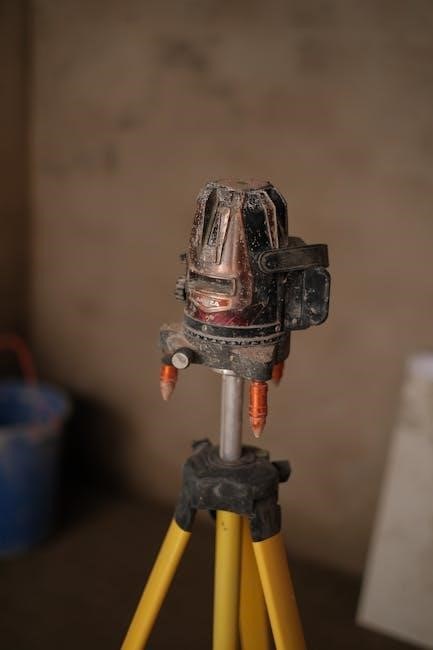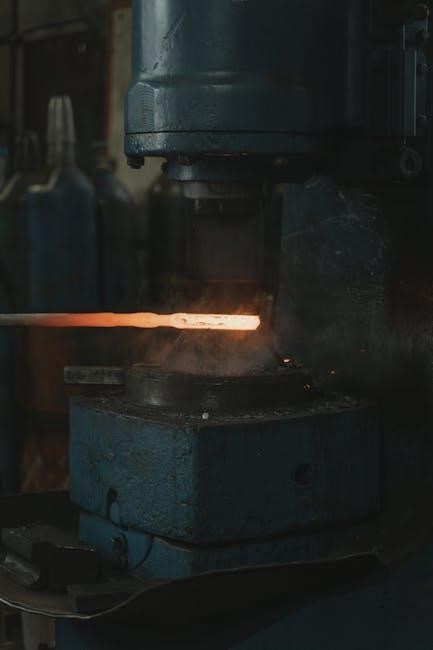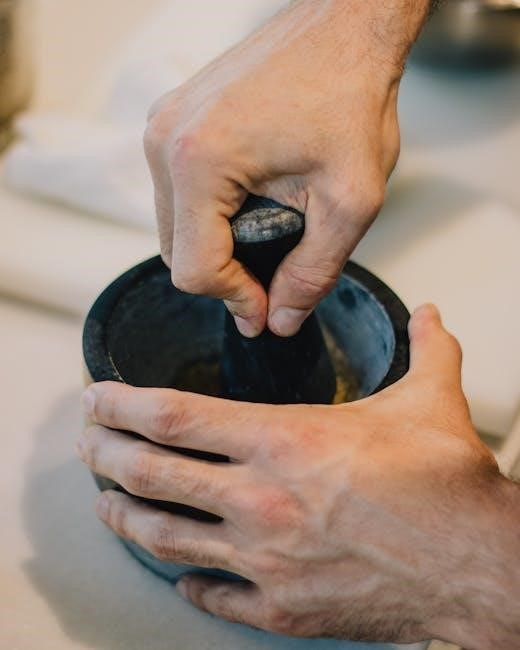Welcome to the Presto Pressure Canner Manual‚ your comprehensive guide to safe and efficient food preservation. This manual provides detailed instructions for pressure canning and cooking‚ ensuring optimal results while maintaining safety standards. With step-by-step guidance‚ it helps users master the art of preserving nutritious meals using the Presto Pressure Canner. Discover how to process low-acid foods‚ cook efficiently‚ and maintain your appliance for years of reliable service.
1.1 Understanding the Presto Pressure Canner
The Presto Pressure Canner is a versatile kitchen appliance designed for safe and efficient food preservation through pressure canning and cooking. It is specifically engineered to process low-acid foods like vegetables‚ meats‚ and poultry‚ ensuring they are sterilized at high temperatures to prevent spoilage and foodborne illness. The canner features a durable construction‚ a locking lid with a pressure-tight seal‚ and an overpressure plug for safety. It also includes a dial gauge to monitor and regulate pressure levels. Unlike traditional cooking methods‚ the Presto Pressure Canner significantly reduces cooking time‚ retaining nutrients and flavors. Suitable for both beginners and experienced users‚ it is a reliable tool for home canning and meal preparation. Always refer to the manual for specific instructions to ensure proper use and safety.
1.2 Importance of Using a Pressure Canner for Home Canning
Using a pressure canner like the Presto model is essential for safe home canning‚ especially for low-acid foods such as vegetables‚ meats‚ and poultry. Unlike boiling water bath canners‚ pressure canners achieve high temperatures necessary to kill harmful bacteria and spores‚ ensuring food safety and preventing spoilage. The USDA recommends pressure canning as the only reliable method for preserving low-acid foods. This method also retains nutrients and flavors while reducing cooking time significantly. By following the Presto Pressure Canner Manual‚ users can ensure their food is properly sterilized and sealed‚ making it safe to eat for years. Proper usage of a pressure canner is crucial to avoid health risks and maintain the quality of preserved foods. Always adhere to guidelines and safety precautions outlined in the manual for optimal results.
1.3 Key Features of the Presto Pressure Canner
The Presto Pressure Canner is equipped with essential features that make it a top choice for home canning and cooking. It includes a dial gauge for precise pressure monitoring‚ ensuring safe and accurate processing. The canner also features automatic venting‚ which simplifies the pressure regulation process‚ and a jar warming function to prepare jars for filling. Its large capacity allows for efficient batch processing‚ while the durable construction ensures long-lasting performance. The Presto Pressure Canner is induction compatible‚ offering versatility for various stovetops. Additionally‚ it comes with a sealing ring and overpressure plug for safety and proper sealing. These features‚ combined with its ease of use‚ make the Presto Pressure Canner an ideal tool for preserving nutritious meals and cooking a variety of dishes efficiently.

Safety Precautions and Guidelines
Always follow safety guidelines to ensure safe operation. Monitor pressure carefully‚ avoid overfilling‚ and keep the vent pipe clear. Regular maintenance and annual testing of the dial gauge are crucial for accurate pressure readings and safe canning practices.
2.1 Understanding Pressure Canning Safety
Pressure canning safety is paramount to prevent spoilage and foodborne illness. The Presto Pressure Canner operates by creating high temperatures through steam pressure‚ essential for killing harmful bacteria in low-acid foods like vegetables and meats. Proper sealing ensures a vacuum-tight environment‚ while the overpressure plug acts as a safety valve to release excess steam if pressure exceeds safe levels. Regular testing of the dial gauge ensures accurate pressure readings‚ crucial for maintaining safety standards. Always follow USDA guidelines and the manufacturer’s instructions for processing times and pressures to guarantee safe and effective canning. Understanding these principles helps users operate the canner confidently and safely‚ preserving nutritious meals for years to come while avoiding potential hazards.
2.2 Essential Safety Tips for First-Time Users
For first-time users‚ understanding safety is crucial when using the Presto Pressure Canner. Always read the manual thoroughly before use to familiarize yourself with its operation. Never leave the canner unattended during operation‚ as consistent monitoring is essential. Ensure the vent pipe is clear of obstructions to allow proper steam release. Use the recommended pressure settings and processing times to avoid under- or over-cooking. Keep children away from the canner while it is in use. Regularly inspect and maintain the sealing ring and overpressure plug to ensure they are in good condition. Avoid overfilling the canner‚ as this can lead to clogging and safety hazards. Follow USDA guidelines for safe canning practices to prevent spoilage and foodborne illness. By adhering to these guidelines‚ you can enjoy safe and successful pressure canning experiences.
2.3 Common Mistakes to Avoid When Using the Presto Pressure Canner
When using the Presto Pressure Canner‚ it’s important to avoid common mistakes to ensure safety and effectiveness. Overfilling the canner is a frequent error‚ as it can lead to clogged vents and pressure issues. Always follow the recommended fill levels‚ especially for foods like soups or dried vegetables that expand during cooking. Another mistake is failing to test the dial gauge annually‚ which can result in inaccurate pressure readings. Ignoring USDA guidelines for processing times and pressures can compromise food safety. Additionally‚ not allowing the canner to vent properly before opening can cause scalding steam to escape. Lastly‚ neglecting to inspect and replace worn-out parts‚ such as the sealing ring‚ can lead to poor performance. By avoiding these mistakes‚ you can ensure safe and successful pressure canning experiences.

Preparing Your Presto Pressure Canner
Unpacking and assembling your Presto Pressure Canner is the first step to ensuring safe and effective canning. Always preheat and test the canner before use to confirm proper function and readiness for processing.
3.1 Unpacking and Assembling the Canner
When you receive your Presto Pressure Canner‚ carefully unpack all components‚ including the canner body‚ lid‚ sealing ring‚ and overpressure plug. Inspect each part for damage or defects. Before assembly‚ thoroughly wash all components with warm soapy water and rinse well. Refer to the manual for specific assembly instructions‚ ensuring the sealing ring is properly seated in the lid and the overpressure plug is securely fitted. Once assembled‚ preheat the canner according to the manual to test its function and ensure a proper seal. This step is crucial for safe and effective pressure canning. Always follow the manufacturer’s guidelines to avoid assembly errors and ensure optimal performance.
3.2 Preheating and Testing the Canner
Before first use‚ preheat and test your Presto Pressure Canner to ensure proper function. Place the canner on your stovetop‚ add 2-3 cups of water‚ and bring to a boil. Allow it to vent steam for 10-15 minutes to verify that the vent pipe is not clogged and the sealing ring is functioning correctly. This step ensures the canner reaches the correct pressure and maintains a safe environment for food preservation. After testing‚ turn off the heat and let the canner cool slightly before proceeding. Regular testing helps maintain the canner’s efficiency and ensures safe operation. Always refer to the manual for specific preheating instructions tailored to your Presto model. Proper preheating is essential for achieving accurate pressure levels and consistent results in pressure canning and cooking.
3.4 Understanding the Sealing Ring and Overpressure Plug
The sealing ring and overpressure plug are critical components of your Presto Pressure Canner. The sealing ring ensures a pressure-tight seal between the lid and the canner body‚ allowing the unit to build and maintain pressure safely. Inspect the sealing ring regularly for cracks or wear and replace it if damaged. The overpressure plug acts as a safety feature‚ releasing excess pressure if it builds too high. Clean both parts thoroughly after each use to prevent food residue buildup. Proper maintenance of these components is essential for safe and efficient pressure canning. Always refer to your Presto manual for specific instructions on inspecting and replacing these parts. Regular checks ensure reliable performance and prevent potential hazards during cooking or canning processes.

Processing Food with the Presto Pressure Canner

Process low-acid foods like vegetables‚ meats‚ and poultry safely and efficiently. Follow USDA guidelines for pressure canning to ensure food safety and optimal results. This method preserves nutrients while reducing cooking time significantly.
4.1 Step-by-Step Guide to Pressure Canning
Pressure canning is a precise process that ensures food safety and preservation. Start by preparing food according to USDA guidelines‚ packing it into clean‚ hot jars‚ and adding liquid as specified. Place jars in the canner‚ leaving space as recommended. Secure the lid‚ ensure the vent is open‚ and heat on high until steam flows freely. Allow the canner to vent for 10 minutes before sealing. Once sealed‚ bring the canner to the recommended pressure and process for the specified time. After processing‚ turn off the heat and let the pressure drop naturally. Remove jars carefully and let them cool. Store sealed jars in a cool‚ dark place. Always follow safety guidelines to avoid overfilling and ensure proper venting for optimal results. This method ensures nutritious‚ shelf-stable meals year-round.
4.2 Pressure Cooking with the Presto Canner
Pressure cooking with the Presto Canner is a fast and efficient way to prepare a variety of dishes while retaining nutrients. Start by adding the recommended amount of liquid to the canner‚ followed by your food. Secure the lid‚ ensuring the sealing ring is properly aligned. Turn the burner to high heat until the canner reaches the desired pressure‚ indicated by the dial gauge. Once pressure is achieved‚ reduce heat to maintain it and process for the recommended time. After cooking‚ allow the pressure to drop naturally or use quick-release methods if specified. Always follow guidelines to avoid overfilling‚ as this can lead to clogging. The Presto Canner excels at cooking soups‚ grains‚ and tough cuts of meat to tender perfection in a fraction of the time. Its versatility makes it a valuable tool for both canning and everyday meals.
4.3 Processing Low-Acid Foods: Vegetables‚ Meats‚ and Poultry
Processing low-acid foods‚ such as vegetables‚ meats‚ and poultry‚ requires careful attention to ensure safety and quality. The Presto Pressure Canner is specifically designed to achieve the high temperatures necessary to kill harmful bacteria and create a vacuum seal. Always follow USDA guidelines for processing times and pressures‚ as outlined in the manual. Prepare food by washing‚ chopping‚ and packing it into clean jars‚ leaving the recommended headspace. Process at the correct pressure (usually 10-15 PSI) for the specified time‚ adjusting for altitude as needed. Do not add acidity to low-acid foods‚ as this can compromise safety. After processing‚ allow the canner to cool naturally before removing jars. This step is critical for proper sealing. Regularly check jar seals to ensure they are airtight for safe storage.
4.4 Avoiding Overfilling and Ensuring Proper Venting
Avoiding overfilling is critical to ensure safe and effective pressure canning. Overfilling can lead to clogged vent pipes and excessive pressure buildup‚ which may result in unsafe conditions. For most foods‚ the canner should not be filled more than 2/3 full‚ while for expandable foods like soups‚ rice‚ and dried vegetables‚ the limit is 1/2 full. Proper venting is equally important to maintain consistent pressure and prevent steam blockages. Before processing‚ ensure the vent pipe is clear and unobstructed. The sealing ring must be in good condition to allow steam to escape freely. Regularly inspect the venting system to avoid any blockages. Proper venting ensures even cooking‚ prevents pressure fluctuations‚ and guarantees a safe canning process. Always follow the Presto manual’s guidelines for fill levels and venting to achieve optimal results.
4.5 Monitoring Pressure and Temperature During Processing
Monitoring pressure and temperature is essential during food processing to ensure safety and effectiveness. The Presto Pressure Canner features a dial gauge to measure pressure accurately. Always maintain the recommended pressure level‚ as specified in the manual or recipe‚ to ensure proper sterilization and food safety. For low-acid foods‚ the USDA recommends a minimum of 10 PSI to kill harmful bacteria. Digital models may include temperature sensors for added precision. During processing‚ avoid sudden pressure drops by regulating heat carefully. Use the venting system to release excess steam and stabilize pressure. If the pressure exceeds safe levels‚ refer to the manual for guidance on reducing heat. Proper monitoring ensures that food is processed safely and efficiently‚ adhering to USDA guidelines for home canning. Regular testing of the dial gauge is crucial to maintain accuracy and reliability.

Maintenance and Troubleshooting
Regularly clean and inspect the Presto Pressure Canner to ensure optimal performance. Replace worn sealing rings and overpressure plugs as needed. Annual testing of the dial gauge is recommended for accuracy. Troubleshoot common issues like clogged vents or improper sealing by consulting the manual or manufacturer support.
5.1 Cleaning and Storing the Presto Pressure Canner
Cleaning your Presto Pressure Canner is essential for maintaining its performance and longevity. After each use‚ wash the canner‚ lid‚ and gasket with mild soap and warm water. Avoid using abrasive cleaners or scouring pads‚ as they may damage the finish. Dry all parts thoroughly to prevent rust. Store the canner in a dry place‚ ensuring the lid is left slightly ajar to allow moisture to escape. Regularly inspect the sealing ring and overpressure plug for wear or damage and replace them as needed. Proper storage and maintenance ensure your Presto Pressure Canner remains in good working condition for future use. Always refer to the manual for specific cleaning instructions tailored to your model.
5.2 Troubleshooting Common Issues with the Canner
If your Presto Pressure Canner isn’t functioning properly‚ check for common issues like inaccurate pressure readings or poor sealing. Ensure the dial gauge is tested annually for accuracy‚ as incorrect readings can lead to unsafe canning conditions. If the canner isn’t sealing‚ inspect the sealing ring for wear or misalignment. Clean the ring and lid to ensure a tight seal. For issues with the overpressure plug‚ verify it’s free from blockages. Avoid overfilling‚ as this can clog the vent pipe and cause pressure buildup. If the canner isn’t heating‚ check the stove burner size and ensure proper alignment. Refer to the manual for specific troubleshooting steps tailored to your model. Addressing these issues promptly ensures safe and effective operation of your Presto Pressure Canner.
5.3 Annual Testing of the Dial Gauge for Accuracy
Annual testing of the dial gauge is crucial to ensure accurate pressure readings‚ which are essential for safe canning. Inaccurate gauges can lead to unsafe canning conditions‚ potentially resulting in under-processed or over-processed foods. To test the dial gauge‚ consult your Presto Pressure Canner manual for specific instructions‚ as the process may vary by model. Generally‚ you’ll need to take the gauge to a reputable testing facility or send it to the manufacturer for evaluation. If the gauge is found to be inaccurate‚ replace it immediately. Regular testing ensures your canner operates within safe pressure parameters‚ adhering to USDA guidelines for home canning. Always prioritize accuracy to maintain the safety and quality of your preserved foods. Refer to the manual for detailed steps and recommendations on testing and replacing the dial gauge.
5.4 Replacing Parts: Sealing Rings and Overpressure Plugs
Regular inspection and replacement of the sealing ring and overpressure plug are essential for maintaining the safety and efficiency of your Presto Pressure Canner. The sealing ring‚ located on the cover‚ ensures a pressure-tight seal during operation. Over time‚ it may wear out or crack‚ requiring replacement. Similarly‚ the overpressure plug is a safety feature designed to release excess pressure if it builds up too high. Replace these parts annually or immediately if signs of wear are visible. Always use genuine Presto replacement parts to ensure compatibility and safety. Refer to your manual for step-by-step instructions on how to remove and install these components. Proper maintenance of these parts is critical to prevent accidents and ensure consistent performance. Never operate the canner with damaged or worn-out seals or plugs‚ as this can compromise safety and results.

Resources and Further Reading
Visit the official Presto website for downloadable manuals‚ model-specific instructions‚ and additional guides. These resources offer comprehensive support for safe and effective pressure canning and cooking.
6.1 Downloading the Presto Pressure Canner Manual
Downloading the Presto Pressure Canner Manual is a straightforward process. Visit the official Presto website at www.GoPresto.com and navigate to the support section. Here‚ you can search for your specific model by entering its number. Manuals are available in PDF format for easy downloading and printing. Ensure you select the correct model to access accurate instructions tailored to your appliance. The manual includes detailed guides for pressure canning‚ cooking‚ and troubleshooting. Additionally‚ it provides essential safety precautions and maintenance tips to ensure optimal performance. For further assistance‚ refer to the website’s resources or contact Presto’s customer support for any inquiries.
6.2 Finding Model-Specific Instructions and Recipes
Finding model-specific instructions and recipes for your Presto Pressure Canner is essential for optimal use. Visit the official Presto website at www.GoPresto.com to locate your model number and access tailored resources. Many models‚ such as the 23-quart induction-compatible version‚ offer detailed PDF manuals and recipe guides. These resources provide step-by-step instructions for pressure canning‚ cooking‚ and troubleshooting specific to your appliance. Additionally‚ Presto manuals include a variety of recipes‚ many of which are adapted from USDA guidelines‚ ensuring safety and flavor. For specialized models like the Presto Precise Digital Pressure Canner‚ additional features such as temperature sensors and automatic venting are highlighted. By referring to model-specific materials‚ users can maximize their appliance’s potential and enjoy a wide range of cooking possibilities.
6.3 USDA Guidelines for Safe Canning Practices
The USDA provides essential guidelines for safe canning practices‚ emphasizing the importance of using tested recipes and proper techniques. Always ensure foods are acidic enough or properly processed to prevent spoilage and foodborne illness. For low-acid foods like meats and vegetables‚ pressure canning is mandatory‚ as it reaches the high temperatures needed to kill harmful bacteria. The USDA recommends processing times and pressures based on altitude and food type. Regularly check and maintain your canner’s accuracy‚ especially dial gauges‚ to ensure safe processing. Follow venting procedures carefully to avoid blockages and ensure proper pressure regulation. Adhering to these guidelines guarantees safe‚ high-quality preserved foods. Always consult the latest USDA recommendations for updates and detailed instructions tailored to your specific needs and equipment.

Recipes and Cooking Ideas
Explore classic USDA-tested recipes and creative meal ideas optimized for the Presto Pressure Canner. Discover efficient ways to cook soups‚ rice‚ vegetables‚ and more with precision and flavor.

7.1 Classic Recipes from the Presto Manual

The Presto Pressure Canner Manual offers a variety of classic recipes that are both delicious and safe to prepare. These recipes‚ often adapted from USDA guidelines‚ include timeless favorites like hearty soups‚ tender stews‚ and perfectly preserved vegetables. Discover how to can green beans‚ carrots‚ and meats with ease‚ ensuring nutritious meals year-round. The manual also provides detailed instructions for processing low-acid foods‚ such as poultry and seafood‚ to guarantee safety and flavor. Each recipe is designed to maximize the efficiency of the Presto Pressure Canner‚ allowing you to achieve professional results at home. Follow the step-by-step guides to create mouthwatering dishes while maintaining the highest standards of food preservation. With the Presto Manual‚ you’ll unlock a world of culinary possibilities‚ ensuring every meal is wholesome and satisfying.
7.2 Adapting Your Own Recipes for Pressure Canning
Adapting your own recipes for pressure canning requires understanding the basics of pressure canning and ensuring safety. Always consult the Presto Pressure Canner Manual for guidelines on processing times and pressures. When adapting recipes‚ consider the acidity of the food‚ as low-acid foods require longer processing times to ensure safety. Reduce liquid in recipes‚ as pressure canning concentrates flavors. Avoid using thickeners like flour or cornstarch‚ as they may not cook properly under pressure. Test your adapted recipes in small batches to ensure they meet safety standards and taste preferences. For guidance‚ refer to USDA-approved methods and Presto-specific instructions. Remember‚ safety is paramount‚ so always follow tested procedures when canning homemade recipes.
7.3 Tips for Cooking a Variety of Foods: Soups‚ Rice‚ and More
Cooking a variety of foods like soups‚ rice‚ and more with the Presto Pressure Canner is efficient and delicious. For soups‚ brown ingredients first‚ then add liquids and cook under pressure for 10-20 minutes. Rice cooks perfectly with a 1:1 water ratio‚ reducing cooking time significantly. Experiment with grains like quinoa or barley‚ adjusting water ratios and times as needed. Proteins such as chicken or beans benefit from shorter cooking times—beans in 20-30 minutes and chicken to tender perfection quickly. Vegetables like carrots or potatoes cook fast‚ while delicate greens like spinach need just a few minutes. Utilize the Presto’s features‚ like temperature sensors‚ for optimal results. Avoid overfilling‚ especially with expanding foods. Ensure sealing rings and overpressure plugs are in good condition. Differentiate between pressure canning for preservation and pressure cooking for meals. Adapt recipes by reducing liquid and adjusting times for food density. Always follow safety guidelines‚ including regular maintenance and gauge testing‚ to enjoy safe and efficient cooking experiences.
The Presto Pressure Canner Manual provides a comprehensive guide for safe and efficient food preservation and cooking. By following its instructions‚ users can achieve delicious‚ nutritious meals while adhering to safety standards.
8.1 Summary of Key Takeaways
The Presto Pressure Canner Manual is a vital resource for safe and effective food preservation. It emphasizes the importance of following detailed guidelines to ensure proper canning practices. Key takeaways include understanding the canner’s features‚ adhering to safety precautions‚ and mastering step-by-step processing techniques. The manual also highlights essential maintenance routines‚ such as cleaning and annual testing of the dial gauge. Users are encouraged to explore additional resources‚ like USDA guidelines and model-specific instructions‚ for comprehensive understanding. By adhering to the manual’s instructions‚ users can confidently preserve nutritious meals and enjoy efficient cooking with the Presto Pressure Canner.
8.2 Encouragement for Safe and Effective Pressure Canning
Pressure canning with the Presto Pressure Canner is a rewarding and efficient way to preserve nutritious meals while ensuring safety. By following the manual’s guidelines and adhering to USDA recommendations‚ you can confidently process a variety of foods. Remember‚ safety is paramount‚ so always test your dial gauge annually and maintain your canner properly. Experiment with new recipes and explore the versatility of your Presto Pressure Canner‚ whether canning fresh produce‚ meats‚ or soups. With practice‚ you’ll master the techniques and enjoy the convenience of home-preserved foods. Happy canning and cooking—your journey to delicious‚ safe‚ and healthy meals starts here!
